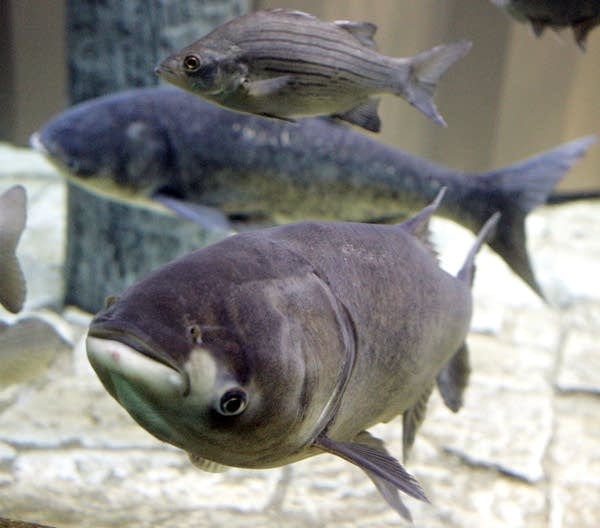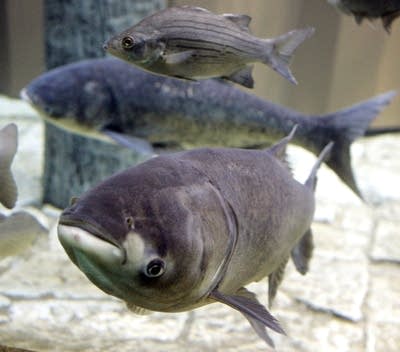Feds update $50M plan to protect Great Lakes from invasive carp
Go Deeper.
Create an account or log in to save stories.
Like this?
Thanks for liking this story! We have added it to a list of your favorite stories.

By JOHN FLESHER
AP Environmental Writer
TRAVERSE CITY, Mich. (AP) -- A federal plan for keeping hungry Asian carp from reaching the valuable fish populations of the Great Lakes calls for reinforcing electrical and other barriers currently in place and for field-testing other methods, including the use of water guns and hormonal fish love potions.
The Obama administration made improving its network of barriers a primary focus of an updated blueprint for keeping bighead and silver carp from reaching the five inland seas, even as they continue infesting the Mississippi River and many of its tributaries. The Associated Press obtained an outline of the government's $50 million plan ahead of its official release later Wednesday.
"This strategy continues our aggressive effort to bolster our tools to keep Asian carp out of the Great Lakes while we work toward a long-term solution," said John Goss of the White House Council on Environmental Quality, who oversees the anti-carp initiative. "The 2013 framework will strengthen our defenses against Asian carp and move innovative carp control projects from research to field trials to implementation."
Turn Up Your Support
MPR News helps you turn down the noise and build shared understanding. Turn up your support for this public resource and keep trusted journalism accessible to all.
The much-maligned carp were imported decades ago to clear algae from fish farms and sewage lagoons in the Deep South. They escaped during floods and have migrated northward, gobbling huge amounts of plankton -- tiny plants and animals that virtually all fish eat at some point. Scientists differ about how widely they would spread in the Great Lakes, but under worst-case scenarios they would occupy large areas and severely disrupt the $7 billion fishing industry.
HUNDREDS OF MILLIONS OF DOLLARS
With this year's spending, the administration will have devoted $200 million over four years to keep the Great Lakes carp-free. But many state officials and advocacy groups contend that the only sure way to prevent invasive species from migrating between the lakes and the Mississippi system is to build dams or other structures near Chicago, where a man-made canal links the two giant watersheds by forming a pathway between Lake Michigan and the Illinois River.
Under pressure from Congress, the U.S. Army Corps of Engineers has promised to release by year's end a short list of options for slamming the door, although such a project could require many years and billions of dollars.
In the meantime, federal officials say an electric fish barrier in the Chicago Sanitary and Ship Canal 37 miles southwest of the city is keeping the carp at bay. Critics note that dozens of water samples taken beyond the barrier have tested positive for Asian carp DNA, although just one live carp has been found there.
The barrier consists of three metal bars at the bottom of the canal that emit electric pulses to repel fish or jolt those that refuse to turn back.
Under the administration's plan, a new section would be added this year to replace a demonstration model installed a decade ago. Two segments at a time will operate, with the third on standby.
To supplement the stationary barrier, the Illinois Department of Natural Resources will oversee design and construction of a mobile electric device that can be dragged behind a boat like a curtain. It could be used in Chicago rivers and canals or elsewhere to herd fish away from places where they don't belong.
The plan also calls for rebuilding a ditch berm to support a chain-link fence in a marshy area near Fort Wayne, Ind., that has been identified as a potential link between the carp-infested Wabash River and the Maumee River, which flows into Lake Erie. Studies suggest that Erie could be particularly vulnerable to a carp invasion because its shallow, warm waters are hospitable to fish.
BEYOND THE LAKES
Other barriers are planned for the Ohio Erie Canal and Little Killbuck Creek in Medina County, Ohio, which have been identified as potential crossover points for invaders.
Additionally, federal agencies will continue developing and testing other methods of catching, killing and controlling the unwanted fish. Methods on the drawing board range from toxins that target Asian carp to water guns and specially designed nets. Scientists also are developing ways to use pheromones -- chemicals secreted by fish to attract mates -- to lure Asian carp to where they could be netted or killed.
Teams also will expand water sampling areas in southern Lake Michigan, western Lake Erie and other likely invasion spots. Other experts are scheduled to complete a study of whether positive DNA hits mean live Asian carp were actually present.
"Much progress has been made in the development and refinement of Asian carp detection and control tools and in the understanding of the food and habitat required for Asian carp reproduction and survival," said Leon Carl, Midwest Region Director of the U.S. Geological Survey. The goal now is to "get these new technologies and information into the hands of managers and other decision makers," he said.




